Bay Island Bonsai maintains a tradition of putting its newest members in the spotlight. Since the organization got its start back in 1998, new members have been subjected to the bonsai “stand exercise.” A group of stands are placed on a table and new members are given the instruction to “arrange them from least formal to most formal.” No other explanation is given.
At a recent meeting, one of our new members included John Thompson, one of the more talented and experienced bonsai artists among us. Here he gets “help” from Jeff and Peter.
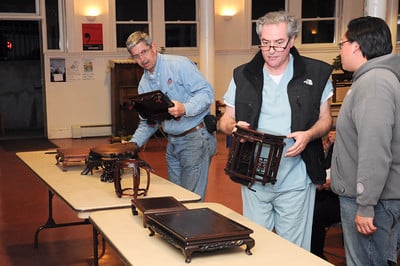
John, Jeff and Peter arrange stands
The exercise usually brings up two questions: 1) What makes one stand more formal than another; and 2) What’s the point of the exercise?
Having watched the exercise unfold for over ten years, it’s clear that most people can supply a pretty good definition of what passes for “formal” without formal bonsai training. Flat bamboo “stands” commonly used for accent plants are usually found to be less formal than taller rectangular stands. Slabs are usually found to be less formal than natural root stands.
Rigid, concrete guidelines can be hard to come by. In general, straight lines are more formal than curved; tall – to a point – is more formal than short; and dark colors are more formal than light. How do tall stands with strong curves and dark colors compare with short, powerful stands with ornate detail? That’s where things get interesting.
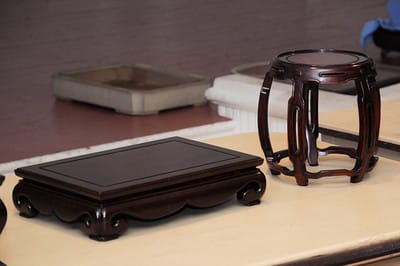
Both stands are dark and make use of curves – which is more “formal”?
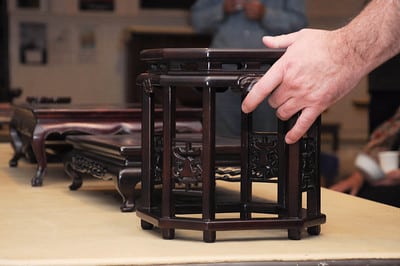
Where does the tall, octagonal stand with intricate details and strong lines fit in?
After getting a feel for gauging formality, one commonly asks why it matters. The answer I’ve held onto the longest begins with an extreme case.
In formal or semi-formal bonsai displays – for these purposes, bonsai displays with trees, stands and accent plants – the stands used can have a big effect on the display’s esthetic. Imagine placing a Japanese black pine with a thick trunk on a ceramic disc next to a tall stand with heavy legs supporting a delicate accent plant. Such an arrangement could put a lot of focus on the accent while downplaying the pine. If the goal is to engage viewers with the pine, one needs to select a stand appropriate to the purpose. This is one reason why I like this exercise – it helps us create the effects we are looking for when we assemble a display.
It also causes us to look at stands closely. The best are beautiful objects on their own. For being quite simple, the sweeping curves on the stand below create a lively, almost playful effect for such a strong and squat stand.
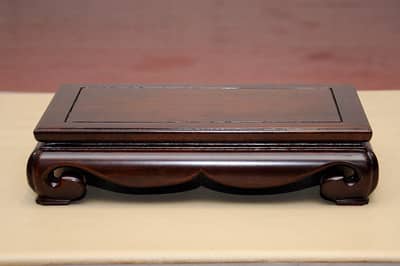
Great curved legs
The stand below is an interesting contrast – it is short and strong with powerful legs that quickly taper to delicate feet. It’s hard to find a good tree for this stand, but well worth the challenge.
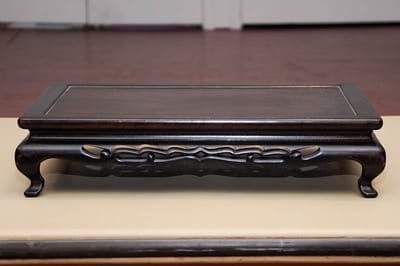
Such tiny feet!
The stands below share several characteristics. They are taller than they are wide and they fit in the general square/round category. In other words, these stands serve well for trees with square, round, or other pots that aren’t rectangular. Which is more formal? I’d vote the stand on the left. It’s taller, darker, heavier – it appears sturdy – and predominantly features straight lines.
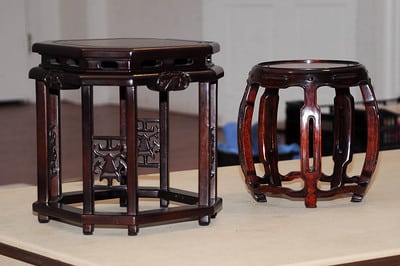
More formal and less formal bonsai stands
Good root stands are a pleasure. They’re super for cascade and semi-cascade bonsai in bonsai exhibits, and good for all sorts of things around the house the rest of the year.
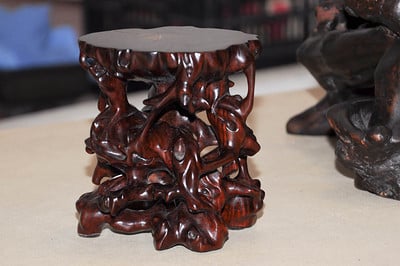
Root stand
Subscribe to Bonsai Tonight
New Posts Delivered Every Tuesday and Friday
Alex says
I fondly remember this exercise. It was good practice, I look at stands a lot differently now.